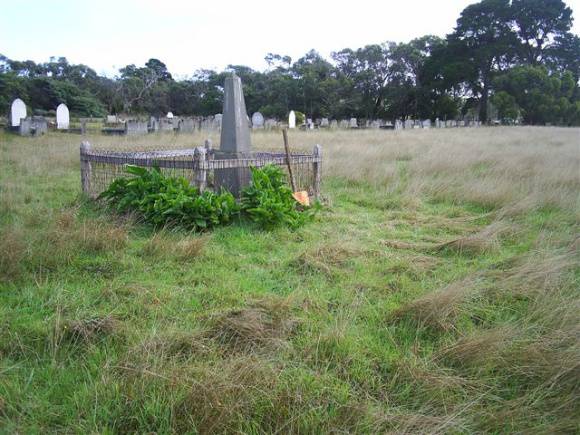| Back to search results » | Back to search page » |
|
NARRAWONG CEMETERY
Location26 NARRAWONG CEMETERY ROAD, NARRAWONG, GLENELG SHIRE LevelRecommended for Heritage Overlay |
|
Statement of Significance
What is Significant?
Narrawong Public Cemetery is a small rural cemetery associated with the early pioneers of the Portland Bay area. The cemetery is located approximately two kilometers north of Narrawong on Cemetery Road, north from the bridge across the Surry River. The cemetery is accessible from gates on the north and southwest sides. The cemetery is rectangular with a central path aligned north-south. An inner rectangle surrounded by a post and wire fence contained most of the marked graves. There are mature Pinus radiata planted on the northern boundary and younger native species along the road boundaries on the west and north. The burials have been arranged in rows out from the central path. The early cemetery was divided into four religious sections with a central cruciform path with gates on the north and south. A number of unmarked graves are known to exist throughout the cemetery.
The cemetery dates from 1863, when three whalers were buried there after dying during the attempted rescue of the Julia shipwreck. The crew of the 'Julia', were rescued by the Portland lifeboat, however six whalers were drowned when they manned a rescue boat from Narrawong Beach. The bodies of three of the men were recovered and buried in the northeast section of the cemetery. Captain William Pelham Dutton, one of the earliest settlers in Portland Bay, is buried on the east side of the cemetery. Dutton was born in Sydney in 1805 and came to Portland as a whaler on early seasonal whaling vessels from the early 1820s and is known to have been in Portland yearly from 1828. Dutton settled permanently near the mouth of the Surry River near Narrawong, gaining one square mile of land in 1844 and purchasing the land allotments in 1852. Dutton died in 1878 and was buried at the Narrawong Cemetery. A memorial obelisk was erected in 1934, by a Centenary committee set up to commemorate Portland's settlement in 1834, the first permanent settlement in the colony of Victoria. The obelisk is fenced by a post and rail wire fence dating from around the same time. Captain Dutton's wife, whose grave is unmarked, was buried next to him on her death. The cemetery contains the graves of many pioneer settlers in the Narrawong and Tyrendarra area including William and Sarah Quick, Samuel Troeth, Walter Duff, Henry Snell Davis and Samuel Brownlaw.
How is it Significant?
Narrawong Cemetery is of historical and social significance to the State of Victoria.
Why is it Significant?
Narrawong Cemetery is of historical significance for its collection of burials known to date back to 1863. It is of social significance as the burial place of many early settlers of the Narrawong and Tyrendarra area which closely followed the settlement of Portland Bay in 1834. The cemetery is of high significance as the burial site of Captain William Dutton (1811-1878), an early whaler and sea captain who settled at Narrawong and is considered to be one of the first settlers of Portland Bay. It is of further significance as the burial site of three whalers who drowned in the rescue of the Julia shipwreck in 1863, which are the earliest known burials at the site.
Group
Cemeteries and Burial Sites
Category
Cemetery/Graveyard/Burial Ground




